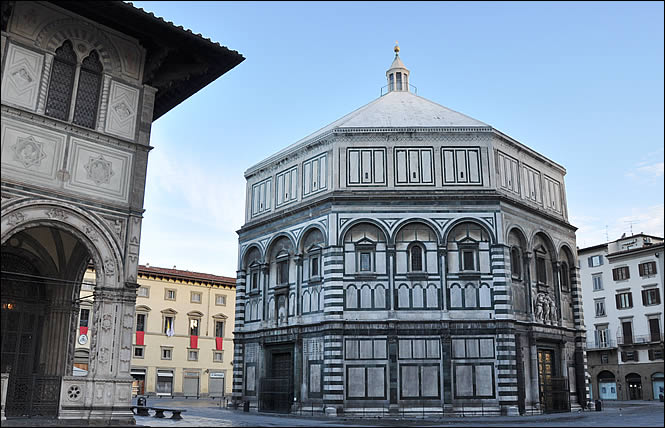Baptistère Saint-Jean
The Baptistery St- Jean in Poitiers is the oldest Christian building in France. It comes in part from the middle of the 4th century ( Roman civil construction ), which was rebuilt in the 7th century in Merovingian Baptistry. The name means Baptistery of St. John.
Exterior
From the eastern side of the tympanum can be the typical rigid decorative forms of early Christianity clearly seen: small pilasters, support the arches and triangular pediment. It is originally classic designs of the Roman Empire, but which are here lost their function and purely decorative elements. You can compare this structure with the gatehouse of Lorsch in Hesse from around 800, which has very similar forms of decoration.
Design of the interior
Inside the baptistery close to the east of the main apse, which was likely to be cultivated at the beginning of the 6th century, and thus represents the oldest Christian interior on French soil. This eastern apse is a hexagonal central space which is outside sheathed rectangular - ie the hexagon is not the outside to bear.
The main room of the baptistery was equipped in the 12th and 13th century frescoes. The building history is not entirely clear. In the 6th or 7th century, the chapel is expanded (and / or increases ) and been the eastern apse was added. In any case, a transverse rectangular room with apses on three sides and subsequently added western stem arose. Only the eastern apse is still original, the other two apses have been changed later.
In the middle of the main room is the oldest baptistery in France. His design indicates that at build time adult baptisms were common, and the person to be baptized to be baptized in the water descended as into a river, like Christ was baptized by John in the Jordan.
The paintings on the east wall are from the period around or shortly after 1100, the simple, rigid structure as on the outside wall has been applied here in the interior -. Having small little columns and overlying triangular shapes. In the center on the east apse where the altar stood, perched Christ in a slightly oval halo. He is accompanied by two floating and making angels and saints standing or apostles.
Some bright spots have been reworked to give a somewhat impressionistic impression has been created that certainly does not match the original appearance. In detail shots can be seen that here the bright lines have been added subsequently and thus appear somewhat exaggerated in the action.
At the lower part of the east wall of several layers of frescoes above the other. You no longer held in the Gothic Romanesque paintings for matching, but instead of removing them, one has simply applied a new layer of mortar and provided with new frescoes. Using methods you can pay off later this layer and make the old Romanesque paintings visible again. Located in Poitiers, this procedure was partially applied, so now parts of two layers meet. The right part of this area is Romanesque and shows a tab called Constantin. Probably it is the Roman Emperor Constantine. The left part of the scene is in the Gothic style in the 13th century
Demolition plans in the 19th century
Despite the unique significance of this building for France threatened him temporarily in the 19th century, the demolition, as it should give way to the system of a road. We changed this plan finally still and the road led around the building.

.jpg)







